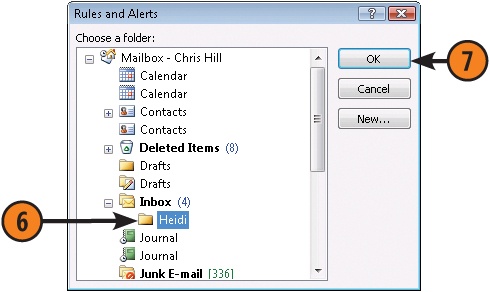Outlook makes it easy to manage your e-mail by using rules. Rules are actions that Outlook performs on your messages to organize them. Once you have Outlook rules set, many management tasks are taken care of automatically when your new messages arrive. To make setting up rules painless, Outlook includes a Rules Wizard that walks you though the process of creating a rule by referring to a message you have already received. You can also create a rule from scratch.
 In the Inbox folder, right-click the message on which you want to base the new rule.
In the Inbox folder, right-click the message on which you want to base the new rule. Click Create Rule on the shortcut menu to display the Create Rule dialog box.
Click Create Rule on the shortcut menu to display the Create Rule dialog box. Choose the action you want Outlook to perform on messages that match the condition(s). For example, select the Move The Item To Folder option.
Choose the action you want Outlook to perform on messages that match the condition(s). For example, select the Move The Item To Folder option.
 With the Inbox folder displayed, choose Rules and Alerts from the Tools menu.
With the Inbox folder displayed, choose Rules and Alerts from the Tools menu. Click Check Messages When They Arrive under Start From A Blank Rule.
Click Check Messages When They Arrive under Start From A Blank Rule. Select the condition(s) under which you want the rule applied, and then click Next.
Select the condition(s) under which you want the rule applied, and then click Next. If the condition requires additional configuration, click the link in the Step 2 field and enter the information.
If the condition requires additional configuration, click the link in the Step 2 field and enter the information. If the action requires further configuration, click the link in the Step 2 field and enter the required information.
If the action requires further configuration, click the link in the Step 2 field and enter the required information.








